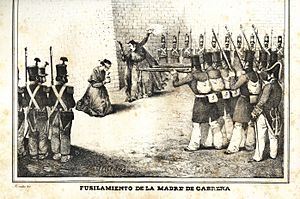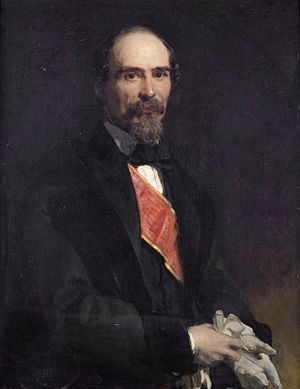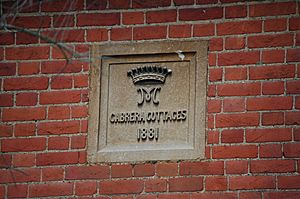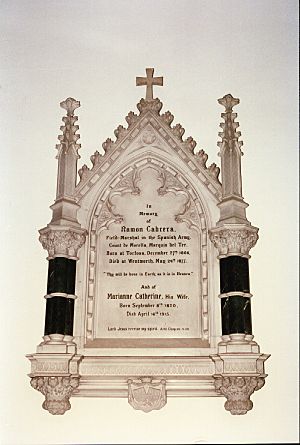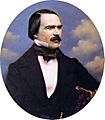Ramón Cabrera, 1st Duke of Maestrazgo facts for kids
Quick facts for kids
Ramón Cabrera
|
|
|---|---|
| 1st Duke of Maestrazgo | |

Daguerreotype of Ramón Cabrera, 1850
|
|
| Born | 27 December 1806 Tortosa, Spain |
| Died | 24 May 1877 |
| Spouse(s) | Marianne Catherine Richards |
| Issue | 4 |
| Father | José Cabrera |
| Mother | Maria Griñó |
Ramón Cabrera y Griñó (born December 27, 1806 – died May 24, 1877) was a famous general from Catalonia, Spain. He fought for the Carlists, a group who supported a different royal family for the Spanish throne. He was known as the 1st Count of Morella and later the 1st Marquis of Ter. He chose to keep these titles instead of a higher one, the 1st Duke of Maestrazgo, which came with money. He wanted the money to go to people who needed it more.
Contents
Who Was Ramón Cabrera?
Ramón Cabrera was born in Tortosa, a city in Spain. His family wanted him to become a priest. So, he went to a special school called a seminary. But Ramón was a very restless student. He often got into trouble and didn't focus on his studies.
His bishop, a church leader, saw that Ramón was not suited for church life. The bishop told him that he should be a soldier instead. Ramón took this advice.
Joining the Carlists
After King Ferdinand VII of Spain died, Ramón Cabrera joined a group called the Carlists. They believed that Ferdinand's brother, Don Carlos, should be king, not Ferdinand's daughter, Isabella. This disagreement led to a war. Ramón had to leave his home and went to Morella. There, he joined the Carlist forces.
The First Carlist War
The First Carlist War began in 1833 and lasted until 1839. Ramón Cabrera quickly became a top leader among the Carlist chiefs. He was known for his bravery, strong beliefs, and fierce fighting style. He led Carlist groups in regions like Catalonia, Aragon, and Valencia.
He built his own army by traveling from village to village. Ramón was very good at surprise attacks. He often won battles against the generals of Queen Isabella. One of his most famous victories was at the Battle of Maella.
"The Tiger of Maestrazgo"
At the start of the war, Ramón Cabrera would release captured enemy officers. He made them promise not to fight him again. However, Queen Isabella's generals later captured Ramón's mother as a hostage. In response, Cabrera ordered the shooting of several mayors and officers.
Sadly, General Agustín Nogueras then ordered Ramón's mother, Maria Griñó, to be shot. This made Cabrera very angry. He vowed that "rivers of blood would flow in Catalonia." After this, he began a harsh policy of revenge. People started calling him The Tiger of the Maestrazgo because of his fierce actions. He took strong revenge for his mother's death.
War's End and Exile
Eventually, a peace agreement called the Convention of Vergara was made. Most Carlist fighters in the north agreed to stop fighting. But Cabrera continued to fight in Central Spain for almost another year.
Two important generals, Espartero and O'Donnell, led a long and difficult fight against him. Finally, in July 1840, they forced him to leave Spain and go to France. The French government held him in a fortress for a few months. After that, he was allowed to go to England. While in England, he had disagreements with Don Carlos, the Carlist leader.
Later Life and Legacy
In 1848, Cabrera returned to Spain and led Carlist groups in Catalonia again. But these groups were quickly defeated, and he had to flee to France once more. After this, he was not as active in the Carlist movement. However, the Carlists still asked for his advice.
Over time, living in England and marrying Miss Richards changed his views. He became less dedicated to the Carlist cause. He also started to believe that the civil war was pointless.
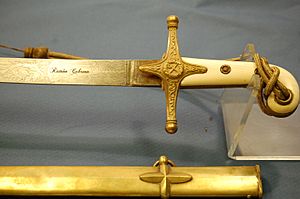
A New Path
In 1875, Cabrera made a big decision. He told all Carlists to follow his example and support the new king, Alphonso XII. Alphonso was Queen Isabella's son. King Alphonso recognized Cabrera's military rank and his title of Count of Morella.
Very few Carlists followed Cabrera's lead. Don Carlos, the Carlist pretender, declared Cabrera a traitor. He took away all of Cabrera's honors and titles.
Cabrera's decision was a major blow to the Carlist cause. Many people, including the Duke of Wellington, respected Cabrera as a skilled military leader. His choice to end the bloody civil war had a lasting impact.
Ramón Cabrera died in London on May 24, 1877. Many people in Spain felt that his change of loyalty had not helped him much. His wife, Marianne, gave up a pension she received in 1899. She did this to help the Spanish treasury after Spain lost its colonies in the Spanish–American War.
Cabrera's tomb is in the churchyard of Christ Church in Virginia Water, England. It is a protected historical site. His wife, Marianne, is buried next to him. They had five children: Maria Teresa, Ramon Alexander, Ferdinand Augustus, Charles Leopold, and Ada Constance.
Images for kids
See also
 In Spanish: Ramón Cabrera para niños
In Spanish: Ramón Cabrera para niños


